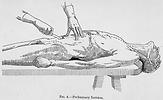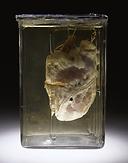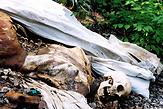Upon a View of the Body
"A dead body tells no tales except those it whispers to the quick ear of the scientific expert, by him to be reported to the proper quarter."
—Sir Andrew Douglas Maclagan, British professor of medicine, Edinburgh University, 1878
In cases of homicide or suspicious death, in medieval England, the coroner, an appointed official who had no medical training, was required to make "a view of the body," a legal, visual inspection. Since then, medical professionals have played an increasingly important role in making views of the body. Physicians and surgeons have developed methods of seeing into the body through autopsy and post-mortem examination—making visible what the untrained, unequipped eye cannot see.
Post-mortem examination
The autopsy
"The mind of the operator should be at the tip of the knife…."
—William S. Wadsworth, M.D., American coroner's physician, 1915
Post-mortem dissection, or autopsy, was among the earliest scientific methods to be used in the investigation of violent or suspicious death. Autopsy remains the core practice of forensic medicine. The postmortem examiner surveys the body's surface, opens it up with surgical instruments, removes parts for microscopic inspection and toxicological analysis, and makes a report that attempts to reconstruct the cause, manner, and mechanism of death. These clips from training films show some of the procedures of postmortem examination.
Tools of the trade
The post-mortem examiner visually surveys the body's surface before opening and entering the body with the help of a scalpel and other instruments. After visual examination of the body cavities, the examiner removes parts for chemical analysis, inspection with a microscope, and other tests. Tools and tool kits specially adapted for use in autopsy first appeared in the early 19th century.
Forensic specimens
For centuries, anatomical specimens from the bodies of crime victims have been used as teaching tools and souvenirs of interesting or important cases. These specimens demonstrate various types of traumatic wounds of the heart, kidney, and stomach. They were prepared in the 1930s by the New York City Medical Examiner's Office.
Changes after death
Physicians and surgeons first gained practical knowledge of death and decomposition through handling and dissecting bodies obtained for anatomical study. Over the course of the 19th and 20th centuries, the study of the decomposed body and body parts—the effects of time, environment, and manner of death—became a vital part of forensic science.
Fauna of the cadaver and time of death
In the 19th century, medico-legal researchers began studying patterns of insect colonization of the cadaver. Entomology, the study of insects, became one of the forensic sciences. By identifying the particular stages that insects go through as they develop on a dead body, and the succession of different species, forensic investigators attempt to determine where a victim died and estimate the time elapsed since death. These adult specimens represent some of the different insect species that colonize a cadaver.
The body farm: studying the science of decay
The Forensic Anthropology Center, at the University of Tennessee, Knoxville, conducts research into the postmortem decomposition of the human body. At the Center scientists study how variations in temperature, exposure, humidity and other environmental conditions affect cadavers and body parts. Their research has helped improve investigators' ability to estimate time of death and to identify individuals from skeletal remains. The Center also maintains a collection of documented human skeletons and has developed software that uses data from thousands of skeletons. Statistics from the database give investigators baselines that help them estimate the race, sex, and stature of unidentified bodies.


